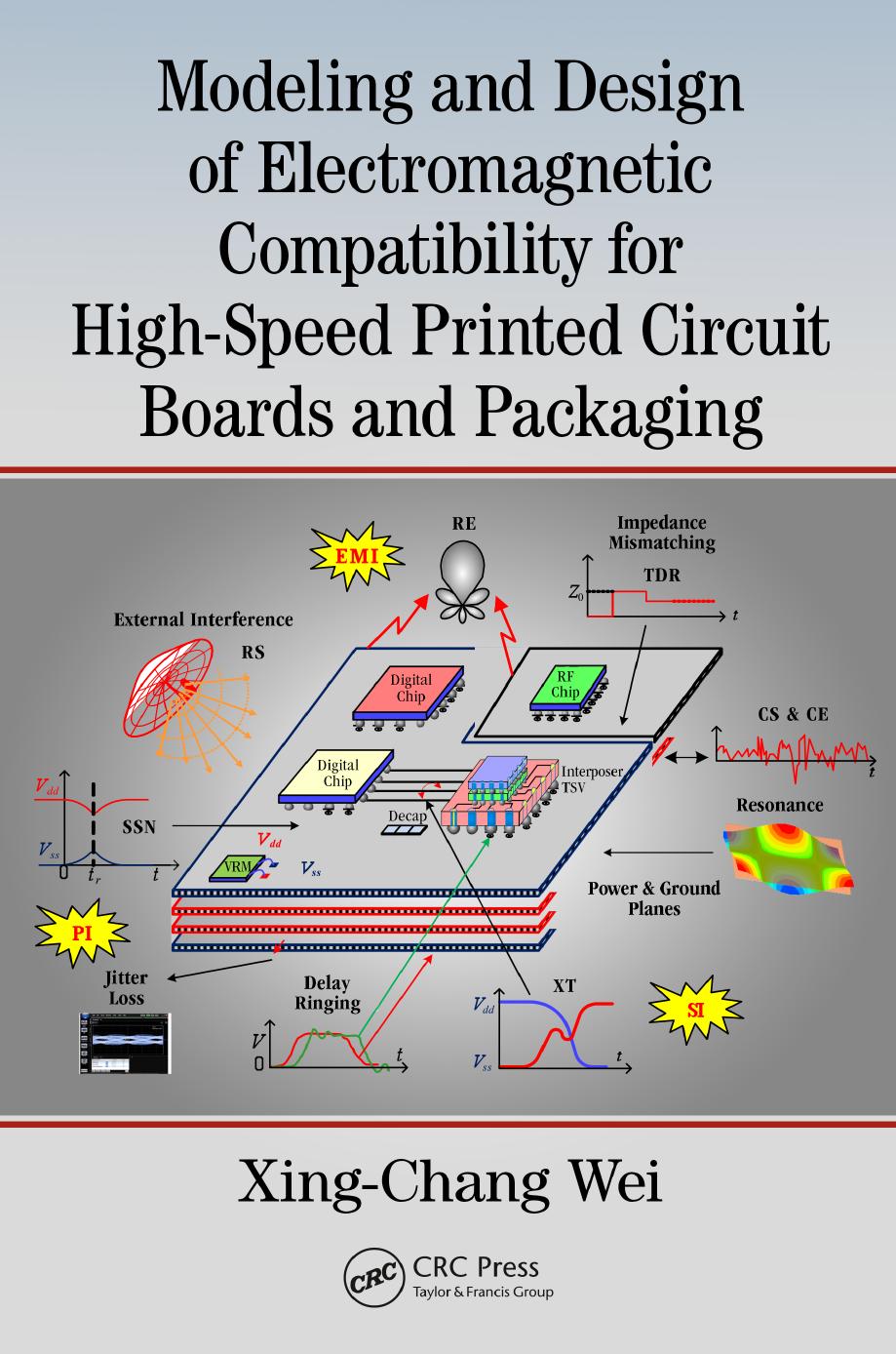Modeling and Design of Electromagnetic Compatibility for High-Speed Printed Circuit Boards and Packaging by Xing-Chang Wei

Author:Xing-Chang Wei [Wei, Xing-Chang]
Language: eng
Format: epub, pdf
Publisher: CRC Press
Published: 2017-03-16T11:12:27+00:00
Integral Equation Solutions ◾ 155
0.5
Via 1
1.8
| Y
Results by using the software HFSS
11| by using the software HFSS
0.4
| Y
Results by using the proposed method
11| by using the proposed method
1.5
Y 11
0.3
1.2
0.9
0.2
0.6
0.1
Amplitude of 0.3
Amplitude of induced current (mA) 0.0
0.0
11
13
15
17
19
11
13
15
17
19
(a)
Frequency (GHz)
(c)
Frequency (GHz)
0.5
Via 2
1.0
| Y
Results by using the software HFSS
22| by using the software HFSS
| Y
0.4
Results by using the proposed method
22| by using the proposed method
0.8
Y 22
0.3
0.6
0.2
0.4
Amplitude of
0.1
0.2
0.0
Amplitude of induced current (mA)
0.0
11
13
15
17
19
11
13
15
17
19
(b)
Frequency (GHz)
(d)
Frequency (GHz)
Figure 3.29 Simulation results for (a) the amplitude of the induced current along
via 1, (b) the amplitude of the induced current along via 2, (c) the input admit-
tance of via 1, and (d) the input admittance of via 2.
planes. Figure 3.29c,d shows the calculated input admittances of via 1 and via 2, respectively. We can observe from Figure 3.29a,c as well as from Figure 3.29b, d
respectively, that the resonant frequencies of the induced currents are the same as
those of the input admittances. This is because the resonant frequencies of a power–
ground structure are inherently determined by its geometry and via layout, that is,
the coefficients matrices [ A], [ C], [ D], and [ Z] in Equations 3.35 and 3.36, whereas the excitations [ E in
out
t ] and [ Et
] at the right-hand sides of Equations 3.35 and 3.36
only affect the amplitudes of these resonances.
For validation purpose, the results from the commercial simulator HFSS [16]
are also plotted in Figure 3.29. Again, a good agreement can be observed. However, the proposed method outperforms HFSS in terms of CPU time (37 minutes as
opposed to two hours and 20 minutes).
3.2.3 Conclusion
In this section, a hybrid 3D integral equation method is proposed to solve the electro-
magnetic emission and susceptibility of power–ground planes with a finite size. Through
numerous numerical examinations, the accuracy and efficiency of this method are
Download
Modeling and Design of Electromagnetic Compatibility for High-Speed Printed Circuit Boards and Packaging by Xing-Chang Wei.pdf
This site does not store any files on its server. We only index and link to content provided by other sites. Please contact the content providers to delete copyright contents if any and email us, we'll remove relevant links or contents immediately.
Linux Device Driver Development Cookbook by Rodolfo Giometti(3957)
Embedded Programming with Modern C++ Cookbook by Igor Viarheichyk(3784)
Implementing Cellular IoT Solutions for Digital Transformation by Dennis McCain(3704)
Embedded Linux Development Using Yocto Project - Third Edition by Otavio Salvador & Daiane Angolini(3553)
TinyML Cookbook by Gian Marco Iodice(3470)
Simplifying 3D Printing with OpenSCAD by Colin Dow(2861)
TinyML Cookbook by Gian Marco Iodice & Ronan Naughton(2623)
Fusion 360 for Makers by Lydia Sloan Cline(2231)
Networking A Beginner's Guide by Bruce Hallberg(2228)
Hands-On Linux for Architects by Denis Salamanca(2073)
But How Do It Know? by J. Clark Scott(2039)
Computers For Seniors For Dummies by Nancy C. Muir(2023)
Raspberry Pi and MQTT Essentials by Dhairya Parikh(1980)
Arduino Project Handbook, Volume 2: 25 Simple Electronics Projects for Beginners by Geddes Mark(1963)
9781803246888-ENHANCING DEEP LEARNING WITH BAYESIAN INFERENCE by Unknown(1918)
Hack and HHVM by Owen Yamauchi(1904)
31 Days Before Your CompTIA A+ Exams (Shanette Luellen's Library) by Benjamin Patrick Conry(1878)
MicroPython Projects by Jacob Beningo(1768)
Hands-On Internet of Things with MQTT by Tim Pulver(1730)
